Mastering the herbal tea flavor wheel reveals a world of sensory delight. You'll learn to identify key categories like floral, fruity, earthy, woody, spicy, and minty notes. By focusing on primary taste profiles and aromas, you'll develop a keen palate for distinguishing subtle flavors. You'll explore how ingredient combinations, processing methods, and brewing techniques impact bouquet complexity and mouthfeel. With practice, you'll refine your tasting skills, from observing dry herbs to experiencing lingering flavors. As you dive deeper, you'll discover how seasonal variations affect herbal profiles and how to create perfectly balanced custom blends. Your journey to becoming an herbal tea connoisseur awaits.
Understanding the Flavor Wheel Concept
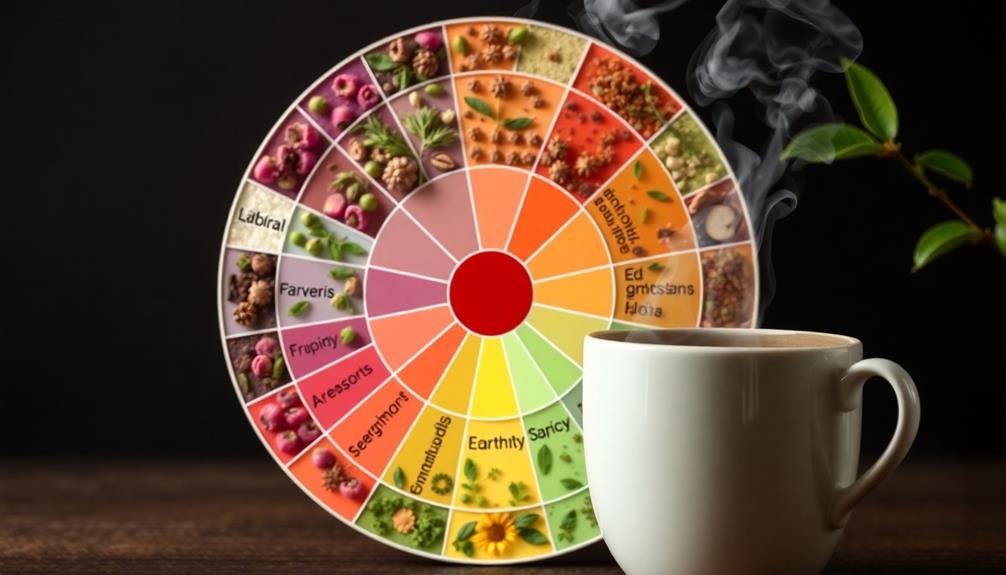
What exactly is a flavor wheel, and why is it important for herbal tea enthusiasts? A flavor wheel is a visual tool that organizes and categorizes different taste and aroma characteristics of a particular food or beverage.
For herbal tea, it's an invaluable resource that helps you identify, describe, and appreciate the complex flavors in your cup.
The wheel typically consists of concentric circles, with broader flavor categories in the center and more specific descriptors radiating outward.
As you move from the center to the outer edge, the descriptors become increasingly precise. This structure allows you to systematically analyze the flavors you're experiencing, starting with general impressions and refining them to specific notes.
Key Flavor Categories in Herbal Teas
When exploring herbal teas, you'll encounter a diverse range of flavor profiles.
You can categorize these flavors into three main groups: floral and fruity notes, earthy and woody profiles, and spicy and minty varieties.
Understanding these key flavor categories will help you navigate the complex world of herbal teas and find your preferred taste experiences.
Floral and Fruity Notes
Floral and fruity notes frequently dominate the flavor profiles of many popular herbal teas. When you're exploring these flavors, you'll encounter a wide range of tastes that can transport you to a blooming garden or a ripe orchard.
Floral notes often include the delicate essence of chamomile, with its apple-like sweetness, or the soothing aroma of lavender. You might detect the subtle perfume of jasmine or the gentle touch of rose petals. These floral flavors can range from light and ethereal to bold and assertive, depending on the blend.
Fruity notes in herbal teas can be equally diverse. You'll find the tart brightness of hibiscus, reminiscent of cranberries, or the sweet-sour punch of rosehip. Citrus flavors like lemon verbena or orange peel add a zesty kick, while berry notes from ingredients like elderberry or blackberry leaves provide a juicy depth.
To fully appreciate these flavors, pay attention to both taste and aroma. Take small sips and let the tea coat your palate. Notice how the floral and fruity notes interact with other flavors in the blend, creating a harmonious or contrasting experience.
Earthy and Woody Profiles
Moving beyond the floral and fruity spectrum, you'll discover a world of earthy and woody flavors that form another essential category in the herbal tea flavor wheel. These profiles add depth and complexity to your tea experience, often evoking images of forests, soil, and aged wood.
Earthy notes can range from mushroom-like umami to the rich aroma of freshly tilled soil. Woody flavors, on the other hand, can remind you of bark, cedar, or even smoky campfires. To help you navigate these flavors, consider the following table:
| Flavor Profile | Common Herbs | Tasting Notes |
|---|---|---|
| Earthy | Burdock root | Nutty, bitter |
| Dandelion | Grassy, mild | |
| Woody | Cinnamon | Warm, spicy |
| Pine needles | Resinous, fresh |
When tasting teas with earthy and woody profiles, pay attention to the mouthfeel. Earthy teas often have a fuller body, while woody teas can leave a lingering sensation on your palate. These flavors pair well with robust foods and can be especially comforting during colder months. Experiment with different brewing temperatures and steeping times to find the perfect balance for your taste preferences.
Spicy and Minty Varieties
A burst of heat or a cool rush can instantly awaken your senses when sipping herbal teas. Spicy and minty varieties offer invigorating flavors that can energize your palate and provide unique sensory experiences.
Spicy herbal teas often feature ingredients like ginger, cinnamon, cardamom, or black pepper. These create a warming sensation and can leave a pleasant tingle on your tongue. Ginger tea, for instance, delivers a zesty kick that's both revitalizing and comforting. Cinnamon-based blends offer a sweet heat that pairs well with other flavors.
Minty teas, on the other hand, provide a cooling effect. Peppermint and spearmint are the most common varieties, but you'll also find blends with less familiar mints like chocolate mint or apple mint. These teas can be incredibly invigorating and are known for their ability to soothe digestive discomfort.
When exploring spicy and minty herbal teas, pay attention to the intensity of the flavors. Some blends offer a gentle warmth or coolness, while others pack a powerful punch.
You'll also find teas that combine spicy and minty notes, creating complex flavor profiles that dance on your palate.
Identifying Primary Taste Profiles

When exploring the world of herbal teas, it's essential to understand the primary taste profiles that form the foundation of their flavors. These profiles help you identify and appreciate the nuances of different herbal blends. The main taste categories you'll encounter are sweet, bitter, sour, salty, and umami.
To develop your palate, start by focusing on one taste profile at a time. Take small sips and let the tea coat your tongue, paying attention to where you perceive the flavors. Sweet notes are often detected on the tip of your tongue, while bitter tastes are more pronounced at the back.
Here's a quick reference guide to help you identify common herbs and their primary taste profiles:
| Herb | Primary Taste | Secondary Notes |
|---|---|---|
| Chamomile | Sweet | Floral, Apple |
| Peppermint | Cooling | Minty, Sharp |
| Hibiscus | Sour | Tart, Fruity |
| Licorice Root | Sweet | Earthy, Woody |
As you practice, you'll become more adept at recognizing these taste profiles and how they interact in complex herbal blends. This skill will enhance your tea-drinking experience and help you choose blends that suit your preferences.
Exploring Aroma and Bouquet Notes
As you explore herbal tea aromas, you'll encounter key profiles like floral, fruity, earthy, and spicy notes.
You can sharpen your ability to identify these scents through regular practice and comparison.
The bouquet's complexity often depends on factors such as the tea's blend composition, processing methods, and steeping conditions.
Identifying Key Aroma Profiles
To truly appreciate herbal teas, you'll need to develop your ability to identify key aroma profiles. These distinct scents can be categorized into several groups, each contributing to the overall sensory experience of your tea.
Start by familiarizing yourself with floral notes, such as lavender, jasmine, and rose. These delicate aromas often provide a sweet, perfumed quality to herbal blends.
Next, explore earthy scents like chamomile, mint, and lemongrass, which offer a grounding, natural essence. Spicy notes, including cinnamon, ginger, and cardamom, add warmth and complexity to many herbal teas.
Don't overlook fruity aromas like berry, citrus, or apple, which can bring a revitalizing brightness to your cup. Woody scents, such as cedar or pine, impart a rich, deep character.
Finally, pay attention to herbaceous notes like sage, thyme, or basil, which contribute a fresh, green quality to many blends.
As you practice identifying these key aroma profiles, you'll enhance your ability to discern the nuances in various herbal teas. This skill won't only deepen your appreciation but also help you choose blends that suit your personal preferences.
Bouquet Complexity Factors
The bouquet complexity of herbal teas stems from three main factors: the variety of ingredients, their quality, and the brewing process. When you're exploring herbal tea bouquets, you'll notice that blends with multiple ingredients often have more intricate aromas than single-herb infusions. Each component contributes its unique scent profile, creating a layered olfactory experience.
The quality of herbs plays a vital role in bouquet development. Fresh, well-preserved ingredients release more vibrant aromas compared to stale or improperly stored ones. You'll find that organic herbs often offer more intense and true-to-nature scents.
Your brewing method greatly impacts the tea's bouquet. Water temperature, steeping time, and the vessel you use can all affect how aromas are released and perceived. Hotter water extracts more volatile compounds, while longer steeping times can bring out deeper, sometimes more bitter notes.
To fully appreciate a tea's bouquet complexity, try this technique: Inhale deeply from the brew, then take small, quick sniffs. This approach helps you detect both prominent and subtle aroma notes, giving you an all-encompassing understanding of the tea's olfactory profile.
Mouthfeel and Texture Characteristics
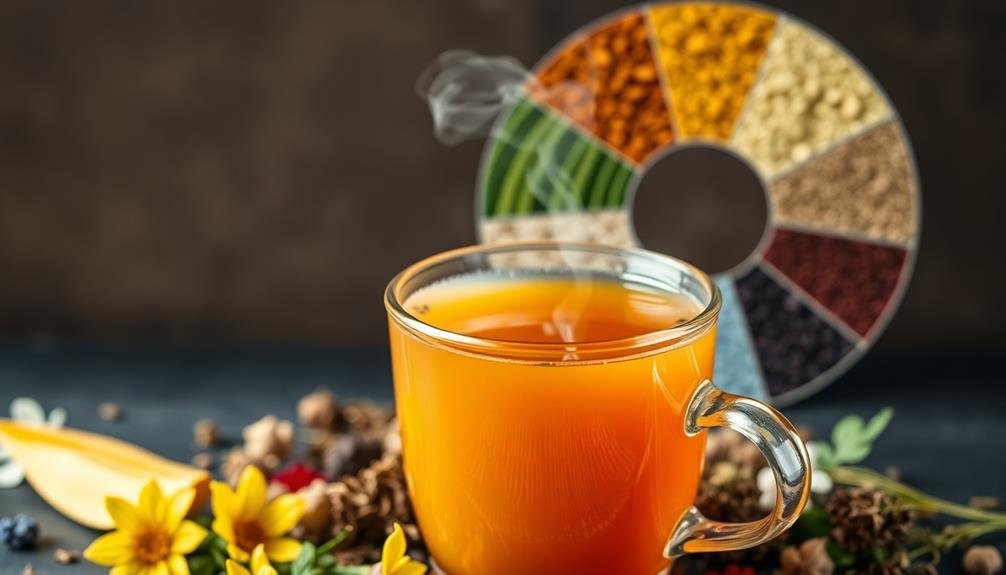
Silky smoothness or robust astringency—these sensations play a crucial role in your herbal tea experience. As you sip your brew, pay attention to how it feels in your mouth. Is it light and delicate, or does it have a full-bodied presence? The mouthfeel can range from thin and watery to thick and syrupy.
Notice any astringency, which creates a dry, puckering sensation on your tongue and palate. This is common in teas with high tannin content. On the other hand, some herbal infusions offer a creamy or buttery texture, coating your mouth pleasantly.
You might encounter a tingling or numbing effect from certain herbs, like peppermint or clove. Some teas can leave a cooling sensation, while others impart a warming feel. The texture can also be influenced by particulates—finely ground herbs may create a slightly gritty mouthfeel.
Don't overlook the finish—how the tea's texture evolves after you've swallowed. Does it leave a lingering sensation, or does it dissipate quickly?
Pairing Complementary Herbal Ingredients
When crafting herbal tea blends, you'll want to explore common flavor combinations that work well together.
You can balance taste profiles by pairing complementary herbs, such as combining sweet and tart ingredients or mixing earthy and floral notes.
Common Flavor Combinations
Delving into the world of herbal tea blending reveals a myriad of exciting flavor combinations. You'll find that certain herbs naturally complement each other, creating harmonious and delightful blends.
Chamomile and lavender, for instance, form a soothing duo that promotes relaxation and sleep. For a revitalizing twist, try pairing peppermint with lemon balm or spearmint.
If you're seeking a warming blend, consider combining ginger with cinnamon and a touch of cardamom. This spicy trio not only tastes great but also aids digestion.
For a fruity infusion, hibiscus works well with rosehips and lemongrass, offering a tart yet sweet profile. Don't forget about the classic combination of rooibos and vanilla, which creates a rich, dessert-like tea.
Experiment with earthy flavors by mixing nettle with dandelion root and a hint of licorice root. For a floral blend, try rose petals with jasmine and a sprinkle of elderflower.
Balancing Taste Profiles
The art of balancing taste profiles in herbal tea blending is essential for creating harmonious and enjoyable infusions. To achieve this balance, you'll need to contemplate the five basic taste sensations: sweet, sour, bitter, salty, and umami. Start by identifying the dominant flavors in your base herbs and then select complementary ingredients to round out the profile.
For a well-balanced blend, pair bitter herbs like dandelion or chicory with sweeter ingredients such as licorice root or stevia. Combine tart hibiscus or rosehips with mellow chamomile or lemon balm to soften the acidity. If you're working with earthy or grassy flavors like nettle or green tea, add bright notes with citrus peels or mint.
Don't forget about mouthfeel and aroma when balancing your blend. Marshmallow root can add smoothness, while ginger provides warmth and spice. Floral ingredients like lavender or rose petals can enhance the overall bouquet.
Enhancing Health Benefits
Herbal tea enthusiasts often seek more than just flavor from their brews. By pairing complementary herbal ingredients, you can enhance the health benefits of your tea while creating unique flavor profiles.
Start by identifying your primary health goal, such as boosting immunity or improving digestion. Then, select a base herb known for that benefit and combine it with complementary herbs that support the same goal.
For example, if you're aiming to reduce inflammation, pair turmeric with black pepper to increase curcumin absorption. To support digestive health, combine peppermint with fennel or ginger. For a calming blend, mix chamomile with lavender or lemon balm. When targeting immune support, combine echinacea with elderberry or rosehips for added vitamin C.
Don't forget to take into account potential interactions between herbs and any medications you're taking. It's always wise to consult with a healthcare professional before incorporating new herbal combinations into your routine.
As you experiment with different pairings, you'll discover that enhancing health benefits doesn't mean sacrificing flavor. In fact, you'll often find that these thoughtful combinations create more complex and satisfying taste experiences.
Balancing Flavors in Custom Blends
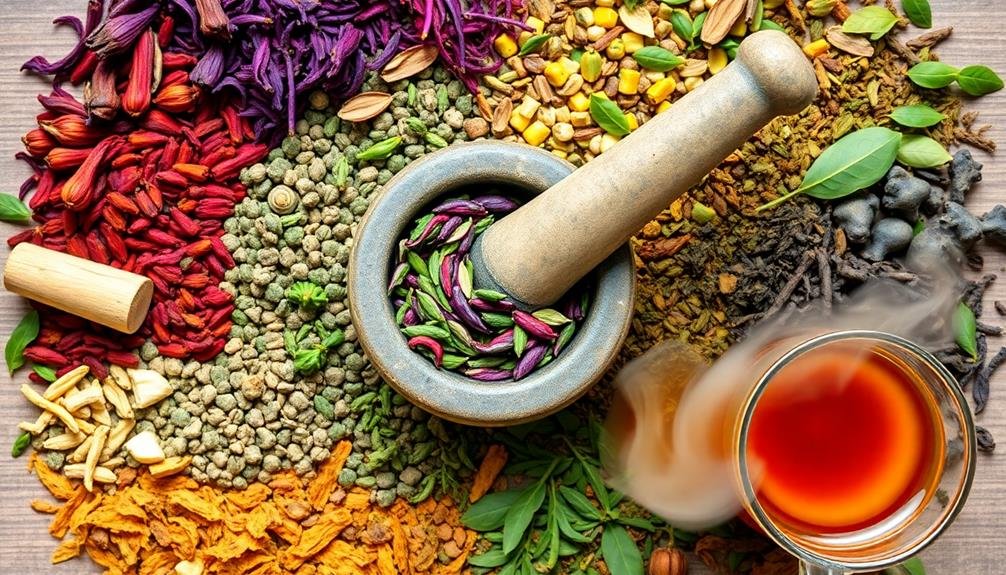
Once you've familiarized yourself with the herbal tea flavor wheel, it's time to put that knowledge into practice by creating your own custom blends. Balancing flavors is key to crafting a delicious and harmonious herbal tea. Start by selecting a base herb that aligns with your desired flavor profile, then build upon it with complementary ingredients.
Consider these four steps when balancing flavors in your custom blends:
- Identify your primary flavor: Choose a dominant herb that will set the overall tone of your blend.
- Add depth: Incorporate secondary herbs that enhance or contrast with the primary flavor.
- Include supporting notes: Select herbs that provide subtle undertones and round out the blend.
- Fine-tune with accents: Add small amounts of potent herbs or spices to create complexity and interest.
Remember to taste your blend throughout the process and adjust as needed. Don't be afraid to experiment with different ratios and combinations.
Keep in mind that some herbs may overpower others, so use stronger flavors sparingly. With practice, you'll develop an intuitive sense of how to balance flavors and create unique, satisfying herbal tea blends.
Seasonal Variations in Herbal Profiles
As you perfect your custom blends, it's important to contemplate how the flavors of herbs can change throughout the year. Seasonal variations in growing conditions greatly impact the taste, aroma, and potency of herbs used in tea blends.
In spring, many herbs offer fresh, vibrant flavors with a hint of bitterness. Summer-harvested herbs often have stronger, more robust profiles due to increased sun exposure and higher temperatures.
Fall herbs tend to develop deeper, more complex flavors as plants prepare for dormancy. Winter-harvested herbs, though less common, can provide unique, sometimes subtle tastes.
To account for these variations, you'll need to adjust your blending techniques. Consider using slightly less of summer herbs to avoid overpowering other flavors.
Conversely, you might need to increase the amount of winter-harvested herbs to achieve the desired intensity. Pay attention to how different growing seasons affect the balance of sweet, bitter, and aromatic notes in your blends.
Tasting Techniques for Herbal Infusions
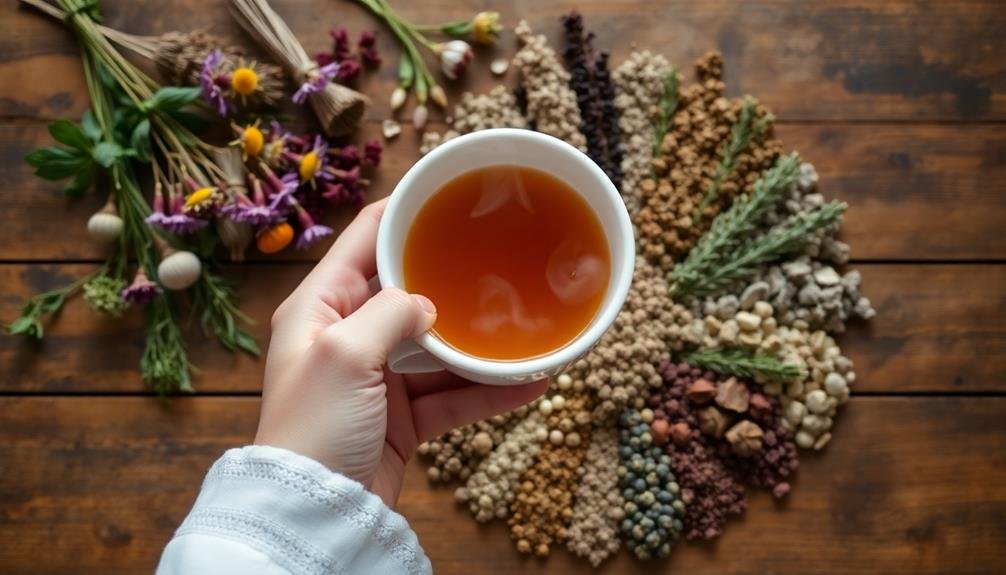
To fully appreciate the nuances of herbal infusions, you'll need to develop a systematic approach to tasting. Start by observing the dry herbs, noting their appearance, aroma, and texture. As you steep the infusion, pay attention to how the aroma evolves and intensifies.
When you're ready to taste, follow these steps:
- Slurp: Take a small sip and draw it across your palate with a slurping sound. This aerates the liquid, helping to distribute flavors evenly.
- Swish: Move the infusion around your mouth, coating all areas of your tongue and cheeks. Different taste receptors will pick up various flavor notes.
- Swallow: As you swallow, notice any lingering flavors or sensations in your throat.
- Breathe: Exhale through your nose after swallowing to experience retronasal aromas.
Between sips, cleanse your palate with water or a neutral cracker. Take notes on the infusion's body, flavors, and aftertaste.
With practice, you'll develop a refined palate capable of discerning subtle differences between various herbal blends. Don't rush the process; savoring each sip mindfully will enhance your overall tasting experience and deepen your appreciation for herbal infusions.
Developing Your Palate Over Time
Consistently refining your palate for herbal teas is a journey that requires patience and dedication. As you begin this path, you'll discover that your ability to distinguish subtle flavors and aromas improves over time. Start by tasting a wide variety of herbal teas, focusing on one flavor profile at a time. Take notes on your observations and revisit teas periodically to track your progress.
To accelerate your palate development, consider these strategies:
| Strategy | Benefit |
|---|---|
| Blind tastings | Eliminate bias |
| Comparative tastings | Identify nuances |
| Aroma training | Enhance smell recognition |
| Flavor pairing | Understand complementary notes |
Don't be discouraged if you can't immediately identify complex flavors. Your taste buds and olfactory receptors need time to adapt and become more sensitive. Practice mindful tasting, paying attention to the tea's appearance, aroma, taste, and aftertaste. Experiment with different brewing methods and temperatures to understand how they affect flavor profiles. By consistently challenging your palate and expanding your repertoire, you'll gradually develop a more refined and discerning taste for herbal teas.
Frequently Asked Questions
How Do Storage Conditions Affect the Flavor Profile of Herbal Teas?
Storage conditions greatly impact your herbal tea's flavor. You'll find that light, heat, and moisture can degrade the tea's quality. Keep your teas in airtight containers, away from sunlight, and in a cool, dry place for best taste.
Can Herbal Teas Be Used in Cooking or Baking Applications?
Yes, you can use herbal teas in cooking and baking! They'll add unique flavors to your dishes. Try infusing sauces, marinades, or baked goods with herbal teas. You'll create exciting new taste combinations in your culinary adventures.
Are There Any Health Benefits Associated With Different Herbal Tea Flavors?
Yes, you'll find various health benefits associated with different herbal tea flavors. They can boost your immune system, aid digestion, reduce stress, improve sleep, and provide antioxidants. Each flavor offers unique properties that support your overall well-being.
How Do Brewing Methods Impact the Taste of Herbal Teas?
You'll find that brewing methods greatly affect your herbal tea's taste. Steeping time, water temperature, and the ratio of tea to water all impact flavor intensity. Experiment with these variables to customize your perfect cup.
What Role Does Water Quality Play in Herbal Tea Flavor Perception?
Water quality greatly impacts your herbal tea's flavor. You'll notice cleaner, more vibrant tastes with filtered water. Hard water can mute subtle notes, while chlorinated water may introduce off-flavors. Always use fresh, cold water for the best results.
In Summary
You've now revealed the secrets of the herbal tea flavor wheel. With practice, you'll confidently identify tastes, aromas, and textures in your favorite brews. Remember, mastering this skill takes time, so don't be discouraged. Keep exploring new blends, trust your senses, and you'll soon be creating your own unique herbal infusions. Embrace the journey of flavor discovery, and you'll find endless delight in the world of herbal teas.


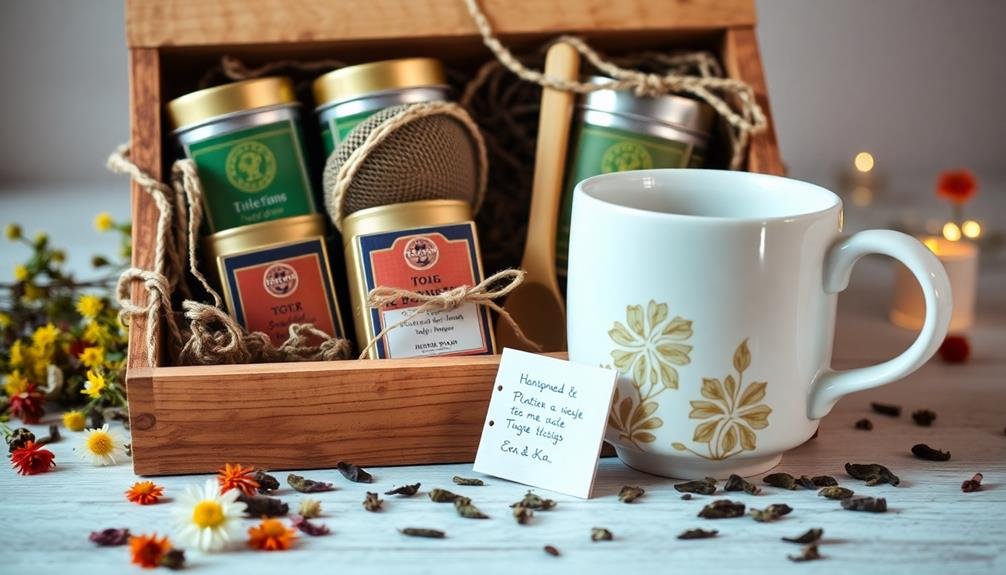
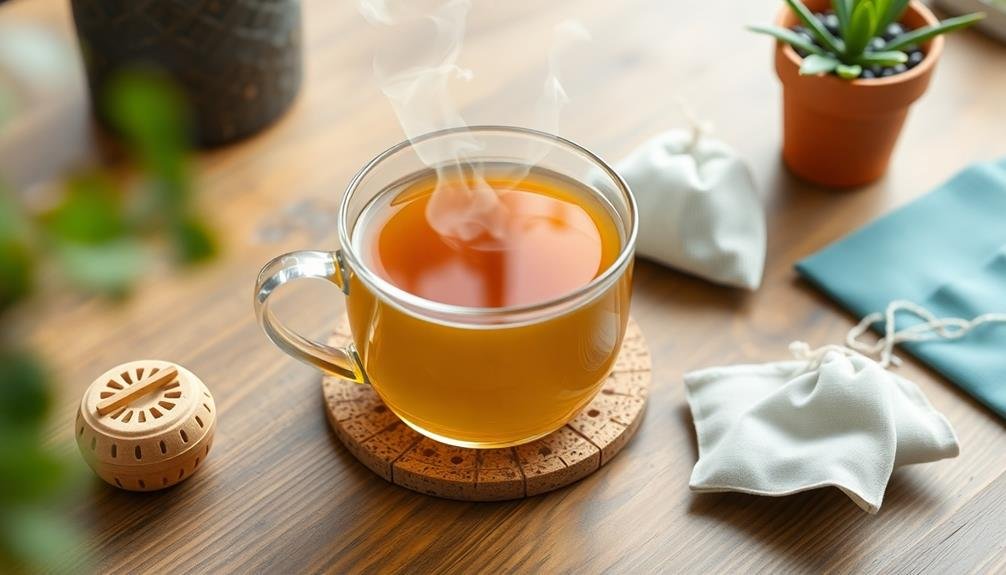
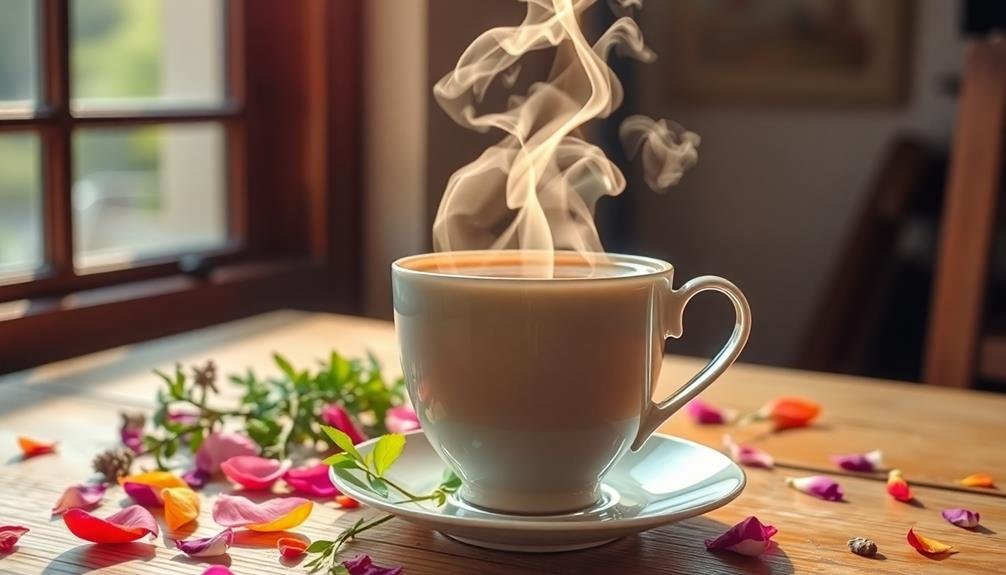
Leave a Reply